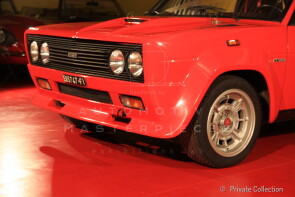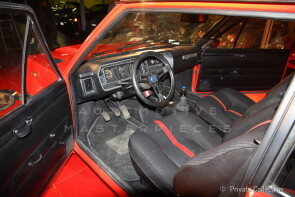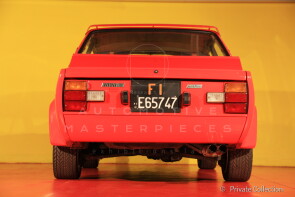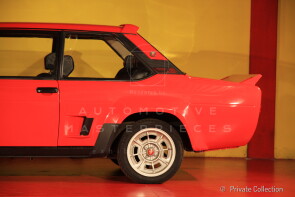
1977 Fiat Abarth 131 Rally
ON/OFF
Why am I an Automotive Masterpiece?
The Fiat 131, additionally called "Mirafiori", was a mid-size family car produced by Fiat from 1974 to 1984. The 131 was the replacement for the successful Fiat 124, available as a two-door and four-door saloon and 5-door estate. The 131 was given the Mirafiori name after the Turin plant where the cars were produced. The 131 employed a front engine, rear-wheel drive layout, whereby the engine is longitudinally mounted in the front of the car. The gearbox is directly behind the engine and a tubular propeller shaft, under the transmission "tunnel", transmits the drive to a solid live rear axle. Initially the 131 came with 1,297 cc or 1,585 cc OHV inline-four engines of the engine family first introduced in the Fiat 124.
In 1976, approximately 400 Fiat Abarth 131 Rally were built for homologation purposes: 350 were sold by Italian Fiat dealers, 50 were given to Abarth for competitions. These cars were built in a cooperation between Fiat, Bertone and Abarth, Fiat's newly acquired motorsport division. Bertone took part-completed two door standard bodyshells from the production line in Mirafiori, fitted front and rear plastic mudguards, widened wheel arches, big air dam, roof and boot spoilers and extra intakes on the bonnet and the flanks. To save weight, all body panels except the roof and doors were made of glass-fiber while the side and rear windows were plexiglass. The rear live axle was replaced by a fully independent suspension with MacPherson struts to improve road holding, regardless of bumps and body roll. The cars were fully painted and trimmed, then delivered back to the Fiat special Rivalta plant where they received the Abarth mechanicals. The street version of the car used a Lampredi-designed 16-valve twin-cam unit, now displacing 1995cc, derivative of the standard DOHC engine which, equipped with a double Weber downdraught carburettor, produced 140 hp at 6400 rpm. The architecture of the light alloy cylinder head is unprecedented and, together with the distribution with two overhead shafts, features four valves per cylinder for the first time on a production Fiat. The gearbox was upgraded to 5-speed with front engagement, which allows quick and precise changes. Of course, all-wheel disc brakes were employed. The competition cars won World Rally Championship 3 times in 4 years – 1977, 1978 and 1980. These cars used dry sump lubrication and, eventually, Kugelfischer mechanical fuel injection. In race specifications, the engine produced up to 240 hp in 1980.
This example of Fiat Abarth 131 Rally with chassis no. 2040585 was produced in 1977 and painted in red colour. It is a street version in absolute pristine condition. It was built for the homologation need of the racing version and, like many cars of this type, spent a sheltered life in the hands of a few lucky enthusiasts and collectors.




